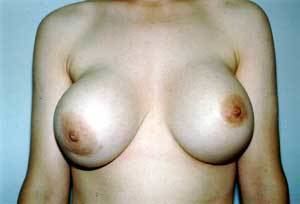 | ||
Capsular contracture is a response of the immune system to foreign materials in the human body. Medically, it occurs mostly in context of the complications from breast implants and artificial joint prosthetics.
The occurrence of capsular contraction follows the formation of capsules of tightly-woven collagen fibers, created by the immune response to the presence of foreign objects surgically installed to the human body, e.g. breast implants, artificial pacemakers, orthopedic prostheses; biological protection by isolation and toleration. Capsular contracture occurs when the collagen-fiber capsule shrinks, tightens and compresses the breast implant, much like the collapse of a bubble gum bubble. It is a medical complication that can be painful and discomforting, and might distort the aesthetics of the breast implant and the breast. Although the cause of capsular contracture is unknown, factors common to its incidence include bacterial contamination, rupture of the breast-implant shell, leakage of the silicone-gel filling, and hematoma.
Moreover, because capsular contracture is a consequence of the immune system defending the patient's bodily integrity and health, it might reoccur, even after the requisite corrective surgery for the initial incidence. The degree of an incidence of capsular contracture is graded using the four-grade Baker scale:
The surgical implantation methods that have reduced capsular contracture include submuscular breast implant placement, using either textured or polyurethane-coated implants, limited handling of the implants, minimal contact with the chest wall skin before their insertions, and irrigating the surgical sites with triple-antibiotic solutions. The correction of capsular contracture might require the surgical removal (release) of the capsule, or the removal, and possible replacement, of the breast implant, itself. Closed capsulotomy (disrupting the capsule via external manipulation), a once-common maneuver for treating hard capsules, was discontinued because it might rupture the breast implant. Non-surgical methods of treating capsules include massage, external ultrasound, treatment with leukotriene pathway inhibitors (e.g. Accolate, Singulair), and pulsed electromagnetic field therapy.
The Mentor Worldwide LLC corporation, one of the three, U.S. FDA-approved breast-implant device manufacturers, conducted a study of the medical complications suffered by breast implantation surgery patients. In March 2000, at a Food and Drug Administration presentation, the Mentor report indicated that 43 per cent of patients with saline breast implants reported medical complications occurring within three years of the surgery; moreover, 10 per cent of that percentage group complained of capsular contracture.
